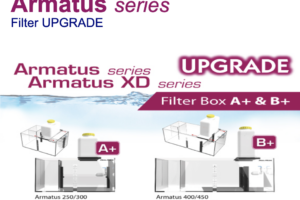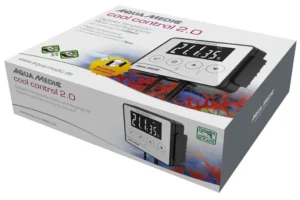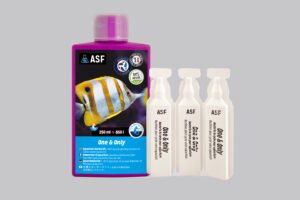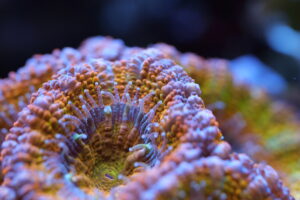Testing the Triton Lab Analysis Kit
The Triton Lab Sea Water Test provides a snapshot of the water quality of your aquarium for many items with excellent accuracy. Using this type of analysis punctually is a big plus compared to the usual colorimetric tests that we use for the Reef aquarium Hobby: more precision and many more elements measured.
Triton lab uses Inductively Coupled Plasma – Optical Emission Spectrometry (ICP-OES) method for the analysis of sea water. The supplied sample is vaporized by plasma at about 8000 ° C. The different elements are quantified via an Optical Emission Spectrometer (OES).
It offers an analysis for many macros and trace elements crucial to the health of your reef aquarium:
Natrium (Na), Calcium (Ca), Magnesium (Mg), Kalium (K), Strontium (Sr), Bor (B), Brom (Br), Schwefel (S), Lithium (Li), Beryllium (Be), Barium (Ba), Titan (Ti), Vanadium (V), Chrom (Cr), Mangan (Mn), Eisen (Fe), Cobalt (Co), Nickel (Ni), Kupfer (Cu), Zink (Zn), Aluminium (Al), Silizium (Si), Arsen (As), Antimon (Sb), Zinn (Sn), Cadmium (Cd), Selen (Se), Molybdän (Mo), Quecksilber (Hg), Phosphor (P), Phosphat (PO 4), Blei (Pb), Jod (I), Wolfram (W), Scandium (Sc), Lanthan (La).
Triton Lab Kit Contents
- The box with a bubble wrap. The box is reusable for return, so do not spoil or throw it away.
- Two plastic tubes with stoppers
- Two self-adhesive labels with a bar code (unique identifier for the kit)
- An explanatory sheet (English & German)
- A self-adhesive label with address for return
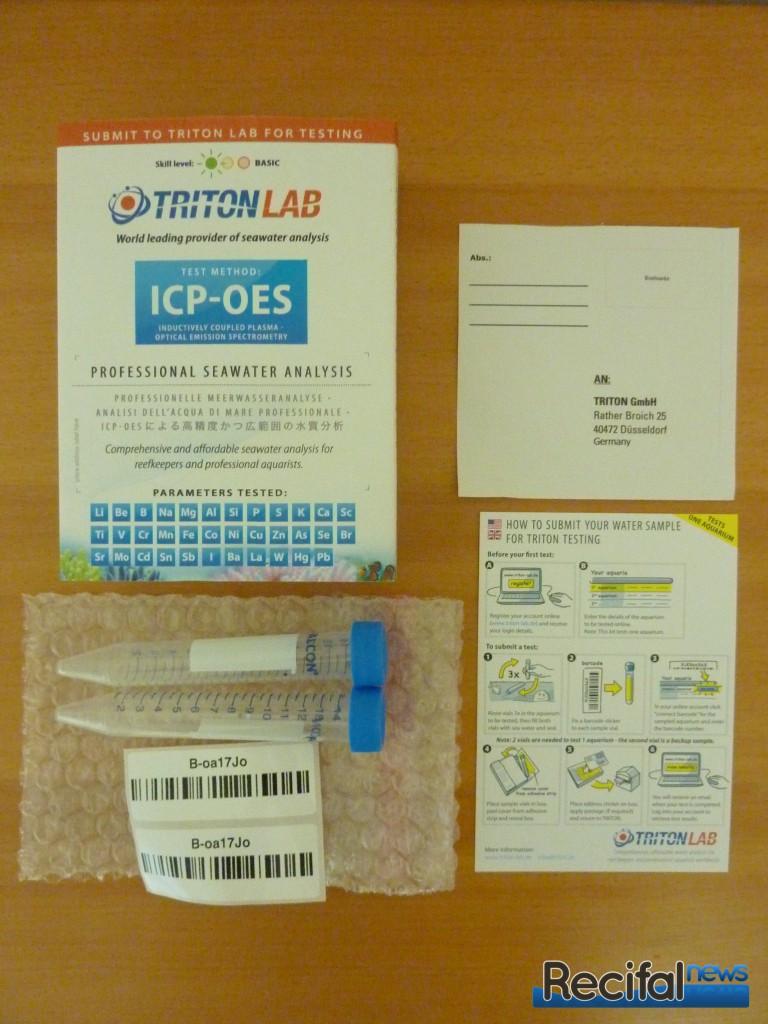
Steps for using the Triton lab analysis kit
Once the Triton Lab kit bought (the price of the kit included the cost of the tests), follow the following steps:
- Create your account online at http://www.triton-lab.de (after selecting the English or German language).
- Enter information about the aquarium to be tested on the site. Note: a test kit per aquarium tested. By indicating the volume of your tank, you will allow them to give you recommendations on supplementing your tank.
- Rinse the tubes three times in the aquarium you want to test and fill the two tubes with the salt water and close them again.
- Paste a label with the bar code on each tube.
- Using your online account click on ‘connect barcode’ for the appropriate aquarium and enter the bare code number.
- Place the samples in the box, remove the adhesive cover and close the box. Note: according to the « method » of opening, you will need to re-paste the box to ensure a good closure.
- Use the sticker with the address on the box and postage or use the post office sticker after having put the address of Triton Lab, according to, and return to Triton Lab.
- You will receive an Email upon receipt of the package and another when the test will be completed. Log in to your account to retrieve the results.
Delays between sending and results during this test:
• Between box mailing (‘Colissimo’ method at French post office for this test) and receipt email (= receipt of the ‘Colissimo’) by Triton Lab: 11 days (from France to Germany). Update of 20/05/2017 : Using an envelope the delay may be 4 days.
• Between receipt email and email for analysis availability to be upload: 1.5 days
Note: I had a small problem with the registration on the website. Contacting the customer service by email, I had an answer and a solution to solve my problem in only 27 minutes (great reactivity)!
The results
Once received the availability email, you can log on to the Triton Lab website. Select the previously configured tank and click on ‘show’. In the ‘Data’ tab, by default, you will get the results of the measurements. If you already have made analysis by Triton Lab, you have the history and will be able to select the test.
The analysis can be consulted directly online, but can also be downloaded as pdf or csv file.
The results are displayed into ‘categories’:
- Unwanted heavy metals (13 measures : Hg, Se, Cd, Sn, Sb, As, Al, Pb, Ti, Cu, La, Sc, W)
- Macro-Elements (8 measures : Na, Ca, Mg, K, Br, B, Sr, S)
- Li-Group (3 measures : Li, Ni, Mo)
- I-Group (4 measures : V, Zn, Mn, I)
- Fe-Group (3 measures : Cr, Co, Fe)
- Ba-Group (2 measures : Ba, Be)
- Si-Group (1 measure : Si)
- Nutrient-Group (2 measures : P, PO4)
Next to each element measured (Analysis), a reference value (Set point) is displayed as well as the difference between the two (Deviation). A Colorimetric Scale allows seeing the positioning graphically.
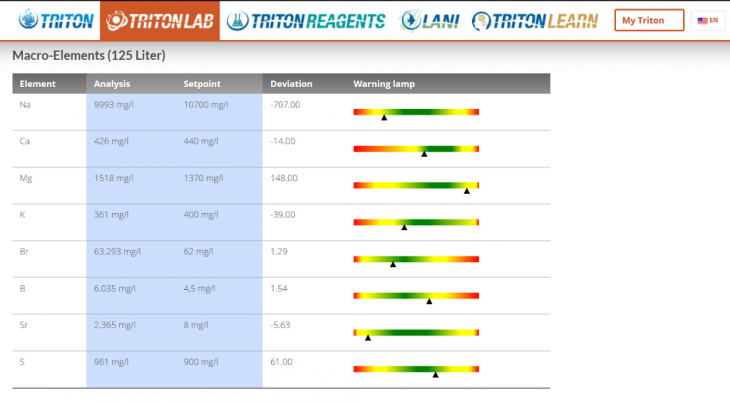
The measured elements are, for some, measurable with the usual tests for the Reef aquarium Hobby (Ca, Mg, PO4 …). This makes possible to compare these various tests. I advise you to make measurements with your usual colorimetric tests at the same time as taking the water sample sent to Triton Lab to give you a comparative idea.
You will find details by element and the detection limits on the Triton Lab website. It’s worth watching to realize that precision is really well above our usual tests. This is probably the most accurate method available to aquarists.
In addition to the analysis, via the ‘Data’ tab, you also have using the ‘Help’ and ‘Dose’ tabs alerts, comments and possible actions to influence the values. Some of the proposals are product-based Triton Lab but you can of course be made via other products for most of the cases. A calculator is also available for dosing additions via Triton Lab products.
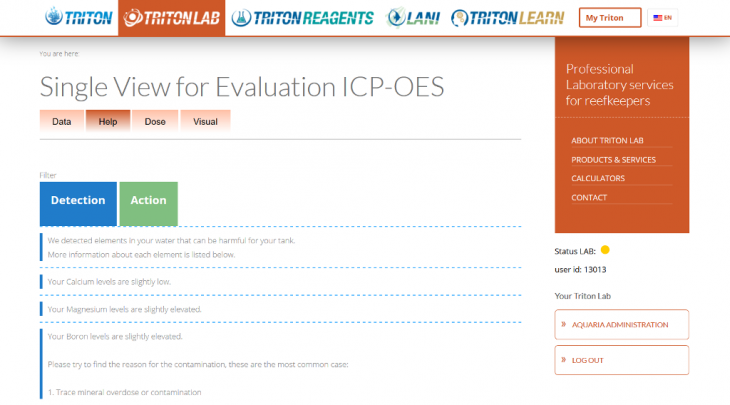
I like
- The large quantity of tests, largely inaccessible to the usual colorimetric tests
- The precision of the tests with the ICP-OES method compared to our usual Reef aquarium Hobby tests.
- Ease of use.
- The results are easily readable with reference values and colorimetric range.
- Results are accompanied with comments and advice.
- The results can be downloaded in pdf format and with history.
- The speed of the test (except post office delays …) and the reactivity of the support.
In an ideal world I would have also liked
- To have the measure of the Salinity or a good estimation. Triton Lab is working to add the salinity soon.
- The kit, emails and the website have only two languages to select, German and English. Other languages may be a plus for some users. The usage of tools like Google Translate may be enough for this type of translation.
I do not like
- Nothing.
Prices
Price: about 35.00 € for the kit + 12.15 € for shipping from France to Germany. Update of 20/05/2017 : recent kit contains one envelope, this allows shipping for 2.20 € with mode ‘lettre prioritaire’.
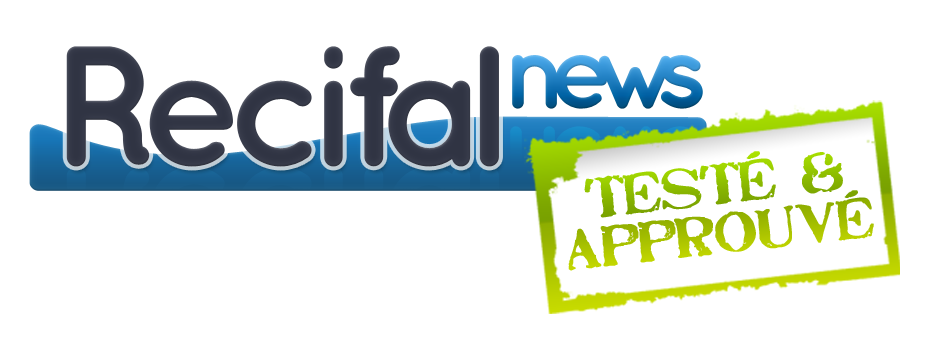
Manufacturer information: www.triton-lab.de
Triton forum: forum.triton.de
Complement (03/03/2017) : Compute salinity using macro-Elements

